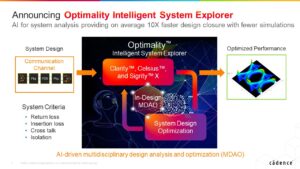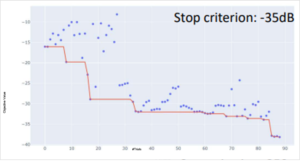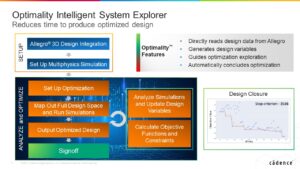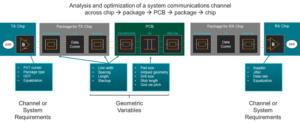
EDACafe Editorial Roberto Frazzoli
Roberto Frazzoli is a contributing editor to EDACafe. His interests as a technology journalist focus on the semiconductor ecosystem in all its aspects. Roberto started covering electronics in 1987. His weekly contribution to EDACafe started in early 2019. AI-driven system design optimization with Cadence Optimality ExplorerJuly 15th, 2022 by Roberto Frazzoli
From a chip to another, traveling through a package, a printed circuit board, and another package: the trip of a high-speed electric signal inside a system is fraught with perils. And avoiding that signals arrive weak and ‘dirty’ at their final destinations is just one of the system-level challenges facing designers today: with ever higher package densities, finer PCB traces, and higher frequencies, crucial aspects now include cooling, stress and more. At the system level, therefore, the interactions among electrical, mechanical, electromagnetic and thermal aspects can no longer be neglected. Unfortunately, the combination of so many different parameters generates an immensely large design space, that system designers are supposed to thoroughly explore to find the optimal solution.
Besides being very human-intensive and requiring a lot of time and computing resources, this task is often hindered by organizational ‘silos’ preventing collaboration among experts from different disciplines. Now a new solution from Cadence, called Optimality Explorer, promises a ten times faster system design optimization – with up to a 100X speedup on some designs – by applying artificial intelligence to a “Multi-disciplinary analysis and optimization” (MDAO) approach. Ben Gu, vice president of R&D for the Multiphysics System Analysis Business Unit at Cadence, described Optimality in the video interview he recently gave to EDACafe’s Sanjay Gangal; in this article we will add a few details, as well as the answers he provided to some additional questions. The conventional brute force, iterative approach to system design optimization As Gu pointed out in the announcement press release, “For years, optimization at the system level has been extremely inefficient based on a human-intensive workflow of design/prototype/test/refine and eventual manufacturing.” And the conventional way of exploring the system design space is usually based on a brute force exhaustive study, such as in parametric studies or ‘design of experiments’. It’s worth noting that also “classic” Multi-disciplinary analysis and optimization – which is not a new concept – can require users to manually set up the experiments for a sweep of simulations, as Cadence’s Frank Schirrmeister pointed out in this blog post: “Defining the limits for all parameters and scanning the design space is possible but results in very computationally expensive simulation setups that examine the entire design space.” Applying artificial intelligence to MDAO The key innovation introduced by Cadence with Optimality Explorer is the application of artificial intelligence to MDAO in electronic system design. This enables to move away from the conventional approach to system design optimization. The artificial intelligence algorithm reduces the design space to be explored, so that a much smaller number of simulations is sufficient. This is the key to improved efficiency and shorter time to results, as parametric sweeps consume large amounts of analysis time and computational resources. “The AI/ML algorithm more expeditiously determines the next simulation to try/run and thus intelligently explores the design space instead of a brute force exhaustive study more typical of parametric studies and/or design of experiments,” Gu explained answering our additional questions. This way, according to Cadence, Optimality Explorer enables designers to quickly determine optimum electrical performance, avoiding suboptimal local minima and maxima, while mapping variations for additional consideration and exploration of the complete design space. An additional explanation has been offered by Cadence’s Frank Schirrmeister in the above-mentioned blog post: “In contrast to simply scanning the entire design space, machine learning models enhance classic heuristics that guide a design implementation towards the optimal design. From a setup of the optimization in which the user defines design variable ranges and specific objective functions, AI/ML maps out the appropriate design space and runs the simulations. It constantly analyzes the simulations, updating design variables and calculating objective functions and constraints until a stop criterion is reached, like the stop criterion of -35dB in the example design space exploration below.” Cadence’s secret sauce But how does Optimality Explorer works? A concept often associated with the use of machine learning in EDA is capturing the experience of human designers from previous designs. However, this is not the case of the new Cadence solution: “Optimality Explorer builds an initial model in the beginning and then improves the model with more evaluations. It does not need specific domain knowledge of human designers,” Gu explained. More clues can be collected considering that Optimality Explorer leverages similar AI technology as used in Cadence Cerebrus Intelligent Chip Explorer. As Gu reminded in the video interview, “[In Cerebrus] we use a reinforcement learning algorithm to build a quick model of the entire design space, because there’s so many parameters. You have a hyperspace to optimize. It’s impossible to do it using the traditional algorithms that rely on derivatives. So we have this derivative-free AI algorithm to build a regression model of the whole design space, so that you use a model instead of real simulations to explore the design space. By doing that, it is much more efficient.” Cadence did not disclose other details about how the Optimality AI/ML algorithm determines the next simulation to try/run and explores the design space: “As for the ‘how’ we do it, this is not an aspect of the product we can share publicly today. However, we believe it is a true innovation and are thus protecting this IP,” Gu commented. Application examples The first Cadence multiphysics system analysis software products to leverage Optimality are Sigrity X for high-speed signal and power integrity simulation and analysis, and Clarity 3D Solver for 3D electromagnetic analysis. As Gu pointed out, shortly the Celsius Thermal Solver for electro-thermal analysis as well as other Cadence multiphysics system analysis products will be added to the list. Primary application examples of Optimality provided by Cadence today are mostly high-speed or signal integrity-centric. “With this view of Optimality Explorer as a multi-disciplinary optimizer, both the electrical performance and physical (layout) parameters can be controlled, varied, and optimized,” Gu said. Specific examples of variant/target couples provided by Gu include anti-pad shape/insertion loss; via number and locations/cross-talk; trace spacing/impedance. “But more complex and nested optimizations are also possible, resulting in a system-level optimized design that can encompass chip, package, board, and more,” Gu maintained. Benefits reported by early adopters Customer endorsement quotes included in the Optimality announcement press release concern 3D electromagnetic analysis applications where the new AI-based product was used in conjunction with Clarity 3D Solver. Ambarella used the combined solution for its DDR package optimization process, meeting its design criteria in a “dramatically shorter” time window. Baidu adopted it for its Kunlunxin AI chip project, and specifically for high-speed channel modeling and optimization, reducing the amount of time spent on optimizing transmission line performance “from hours to minutes”; speed up concerned tuning the physical parameters of a high-speed differential pair routing constraint. MediaTek used the solution for its recent 112G PAM4 SerDes project, achieving optimum return and insertion loss, and TDR waveforms “quickly and efficiently”, leading to “a 75% performance improvement”. Microsoft tested Optimality with Clarity for a rigid-flex PCB with multiple via structures and transmission lines, uncovering “novel designs and methodologies that we would not have achieved otherwise”. According to Gu, benefits achieved by adopting Optimality include reduced reliance to human heuristics in a period of talent shortage. “We all know we are having a lot of trouble hiring electronics design talent,” he said in the video interview. “Those people are really hard to find at this moment. And by using the deep learning algorithm we built into Optimality, we can significantly reduce the reliance on the human heuristics. The AI can make lot of judgment calls. Of course, we still need those experienced engineers to make the final call, but lots of tedious work can be done by Optimality. We can get the design converge to the near optimum results really fast. You can go to sleep, and the computation will still be going on. And the next day, when you come to work, you will get the very good design results. I think that will significantly change the landscape of designing,” he said. Extending AI-based optimization from chip design to system design Optimality Explorer leverages similar AI technology as used in Cadence Cerebrus Intelligent Chip Explorer. “After Cerebrus got launched – Gu reminded in the video interview – we got lots of interest from our customers, and then naturally we saw the opportunity to extend the algorithm to the system design space. And of course, the scenario we are addressing in systems is slightly different from SoCs. So R&D did a lot of work to tune the algorithm, to transplant it from chip space to system space, but the results are equally fabulous, mind blowing.” Optimality shares with Cerebrus the ability to scale and to take advantage of distributed computing resources. According to Cadence, its interface is easy to use, allowing designers to activate Optimality Explorer from the Clarity and Sigrity X environments for fast invocation of MDAO. In the company’s offering, AI-driven optimization can be extended across Cadence’s multiphysics technologies to create a computational software solution spanning simulation, optimization and signoff. The Optimality Intelligent System Explorer is available now to select Cadence customers through early access. The company expects general availability of the product to start in the fourth quarter of 2022. Category: Video Interview |
|
|
|||||
|
|
|||||
|
|||||










